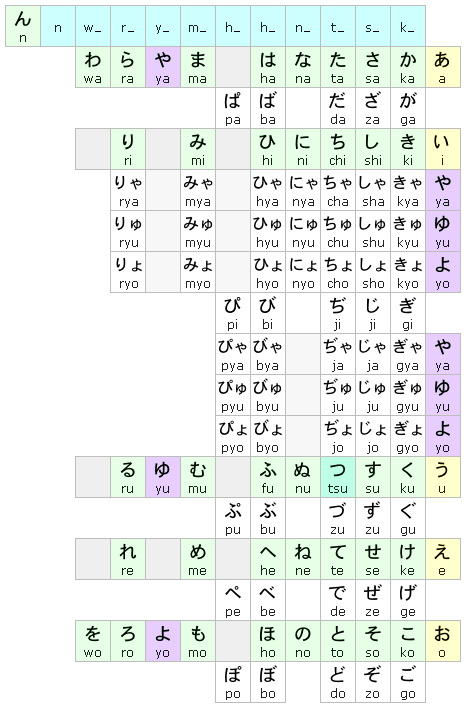平仮名 「ひらがな」 – hiragana
hiragana is a syllabary; the kana (characters) only represent sounds in the Japanese language and have no other meanings*. The blue boxes contain the consonants¹. The yellow boxes contain the five vowels and their kana. The green and purple boxes contain the 40 primary kana formed from a consonant-vowel pair, and the 'short n' kana. The white boxes contain secondary kana that are formed from the primary kana, and the small double slash diacritic mark, or ring diacritic mark, or small 'ya', 'yu', or 'yo' characters. As can be seen from the chart, these secondary characters represent modified primary sounds. In hiragana, a half-height 'tsu' (see blue-green box below) preceeding a consonant is used to indicate a long or double consonant.
* Some of the kana are used as particles – words that indicate what part of a sentence other words are – subject, object, etc.
¹ Actually, Japanese isn't taught as vowels and consonants. In Japan, the hiragana is taught as phonemes – that is one kana (grapheme) is one haku (mora or unit of time).
If you would like to practice writing Japanese in hiragana, here is a
• kana Keyboard based on the chart above.
Download new combined hiragana and katakana chart
• here .
© 2010-2019 shi-yaku-jin no hokora & BigTime Interactive
shi-yaku-jin no hokora, shiyakujin no hokora, shi-yaku-jin, shiyakujin, minzoku, minkan, folk shinto, folk shintou, Neo-Shinto, NeoShinto, Neoshintou, Shinto, Shintou, Shintoism, kami-no-michi, online shrine, virtual shrine, cyber shrine, shrine, hokora, hiragana, phonetic alphabet, syllabary, moraic alphabet, kana, haku, mora, japanese, native words, japanese words, kun-yomi, kun'yomi

